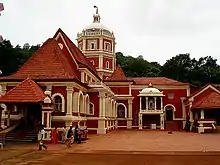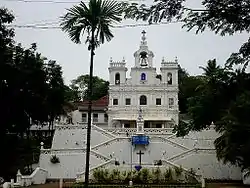Culture of Goa
This article is about the culture of natives of the Indian state of Goa. Goans are commonly said to be born with music and football in their blood. This is because football and music are deeply entrenched in Goan culture.
Religion
According to the 2011 census, in a population of 1,458,545 people, 66.1% were Hindu, 25.1% were Christian, and 8.3% were Muslim. Smaller minorities of about 0.1% each followed Sikhism, Buddhism, or Jainism. Goa has a history of communal harmony.
Festivals
The most popular celebrations in the Indian state of Goa are the Goa Carnival, (Konkani:Intruz), Sao Jao (Feast of John the Baptist)[1] Ganesh Chaturthi (Konkani: Chavoth),[2] Diwali,[3] Christmas (Konkani: Natalam),[4] Easter (Konkani: Paskanchem Fest), Samvatsar Padvo or Sanvsar Padvo, Shigmo,[5] The largest festival in the state is the Feast of St. Francis Xavier (Goicho Saib).[6] Goa is also known for its New Year's celebrations. The Goan Carnival is known to attract a large number of tourists.
Education
Cuisine
Rice with fish curry (Xit kodi in Konkani) is the staple diet in Goa.[7] Goan cuisine is renowned for its rich variety of fish dishes cooked with elaborate recipes. Coconut and coconut oil is widely used in Goan cooking along with chili peppers, spices and vinegar giving the food a unique flavour. Pork and beef dishes such as Vindaloo,[8][9] Xacuti and Sorpotel are cooked for major occasions among the Catholics. An exotic Goan vegetable stew, known as Khatkhate, is a very popular dish during the celebrations of festivals, Hindu and Christian alike. Khatkhate contains at least five vegetables, fresh coconut, and special Goan spices that add to the aroma. A rich egg-based multi-layered sweet dish known as bebinca is a favourite at Christmas. [10] Cashew feni is made from the fermentation of the fruit of the cashew tree, while coconut feni is made from the sap of toddy palms.
Architecture
The architecture of Goa shows a distinct Portuguese influence.
The Churches and Convents of Goa are a group of six churches that are a UNESCO World Heritage site.[11] The Basilica holds the mortal remains of St. Francis Xavier, regarded by many Catholics as the patron saint of Goa (the patron of the Archdiocese of Goa is actually St. Joseph Vaz). Once every ten years, the body is taken down for veneration and for public viewing. The last such event was conducted in 2004. The Velhas Conquistas regions are also known for its Goa-Portuguese style architecture.[12][13]
In many parts of Goa, mansions constructed in the Indo-Portuguese style architecture still stand, though in some villages, most of them are in a dilapidated condition. Fontainhas in Panaji has been declared a cultural quarter, showcasing the life, architecture and culture of Goa.[14] Some influences from the Portuguese era are visible in some of Goa's temples, notably the Mangueshi Temple, although after 1961, many of these were demolished and reconstructed in the indigenous Indian style.
Sports
Football is the most popular sport in Goa,[15] followed by hockey. Cricket, athletics, chess, swimming, table tennis and basketball are other popular sports in Goa. Fishing is also a popular recreational activity.
Science
Arts
Music
Mando and dulpod are traditional goan musical forms.
Goan Hindus are very fond of Natak, Bhajan and Kirtan. Many famous Indian Classical singers hail from Goa, such as, Kishori Amonkar, Kesarbai Kerkar, Jitendra Abhisheki, Prabhakar Karekar.
Many Goans also perform Western classical music
Dance
Some traditional Goan dance forms are dekhnni, fugdi, corridinho and dashavatara. Western social dancing is a part of most celebrations.
Theatre
Goans are very fond of theatre and acting. Kalo and dashavatar were popular art forms. Marathi Nataks have been very popular among Hindus in Goa for the past two centuries. Tiatr is the major Goan form of theatre common amongst Catholics and is the most commercial offering as it has entertained Goans not only in Goa but also in Mumbai and Pune (which are major cities of India and have a sizeable Goan population) and in the Gulf regions of UAE, Kuwait and so on.
Cinema
Literature
Language
Around two-thirds of Goans speak Konkani as their first language, while the remaining speak other languages, such as Hindi and Marathi as their primary language. However, almost all Goans can speak and understand Konkani. Konkani is an important part of the Goan identity that binds together all Goans.
Tourism
Goa developed an international reputation in the 1960s as one of the prime stops on the legendary India-Nepal "hippie trail". In the mid-1960s, several Westerners, including "Eight Finger Eddie" walked over the hill to Calangute, and decided to create a community for Westerners. In the early years, Calangute and Baga were the center of this scene, but it grew over the years to include other nearby cities like Anjuna Beach, which became, and arguably still is, the center of the Western youth culture of Goa. By the mid-1980s, there were over 8000 Westerners living in Goa, mostly from Western Europe. The scene was marked by drug culture, trance music and free love. Goa remains today an international center of youth culture.
Starting in the late 1990s, Goa began to attract a more "upscale" audience, which in turn drove prices up, which in turn drove many in the "hippie" community to other less-expensive areas. Arambol—the beach community furthest away from "civilization", like electricity and running water—became the center of a battle between those wanting to turn Goa into a more traditional upscale resort area, and those wanting Goa to retain its traditional rustic counterculture appeal.
References
- Administrator. "Department of Tourism, Government of Goa, India - SAO JOAO". www.goatourism.gov.in. Retrieved 2018-11-27.
- Administrator. "Department of Tourism, Government of Goa, India - GANESH CHATURTHI or CHOVOTH". www.goatourism.gov.in. Retrieved 2018-11-27.
- Administrator. "Department of Tourism, Government of Goa, India - DIWALI". www.goatourism.gov.in. Retrieved 2018-11-27.
- Administrator. "Department of Tourism, Government of Goa, India - CHRISTMAS". www.goatourism.gov.in. Retrieved 2018-11-27.
- Bravo da Costa Rodrigues, Maria de Lourdes (2004). Feasts, festivals, and observances of Goa. Goa: L & L Publications. pp. 43–74.
- Administrator. "Department of Tourism, Government of Goa, India - FEAST OF ST FRANCIS XAVIER". www.goatourism.gov.in. Retrieved 2018-11-27.
- Chowdhury, Arka Roy (Nov 14, 2018). "Food travel: soul-stirring seafood in India". Times of India Travel. Retrieved 2018-11-27.
- Taylor, Anna-Louise (Oct 11, 2013). "BBC Food - Curry: Where did it come from?". BBC Food. Archived from the original on December 11, 2014. Retrieved 2018-11-27.
- "Indian Classics - Vindalho de Galinha (Chicken Vindaloo)". www.thetiffinbox.ca. Retrieved 2018-11-27.
- "Goa government readies to brand Feni as heritage brew". Mid-Day. 2016-01-23. Retrieved 2018-11-27.
- Centre, UNESCO World Heritage. "Churches and Convents of Goa". UNESCO World Heritage Centre. Retrieved 2018-12-06.
- "Basilica of Bom Jesus, Old Goa | Parish Ministry | Goa Jesuits | www.goajesuits.in". 2014-06-15. Archived from the original on 2014-06-15. Retrieved 2018-11-27.
- "Bom Jesus Basilica sitting on a fire bomb: Church official - Times of India". The Times of India. Retrieved 2018-11-27.
- Datta, Sravasti (2012-11-18). "The quiet Goa: Fontainhas". The Hindu. ISSN 0971-751X. Retrieved 2018-11-27.
- "Craze for football has doubled since ISL: Aaren". The Goan. Retrieved 2018-11-27.

